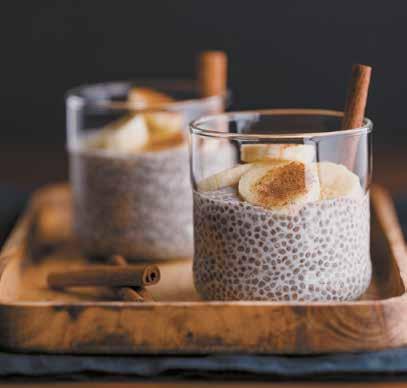
18 minute read
conscious
A Better Breakfast Healthy Tips and Recipes to Start the Day
by April Thompson
Advertisement
Breakfast sets the stage for the day ahead, and it can either drain or energize us, depending on the what, when and how much aspects of the meal. While health experts agree that many traditional breakfast foods can do more harm than good, delicious, healthy alternatives are within easy reach of the breakfast table.
Morning favorites like pastries, sugary cereals and pancakes, high in refined sugars and carbs, cause insulin production to spike and blood sugar levels to crash, according to David Perlmutter, an acclaimed neurologist based in Naples, Florida, and author of Grain Brain: The Surprising Truth about Wheat, Carbs, and Sugar - Your Brain’s Silent Killers. “People need to train their bodies to tap into the energy reserves within, harvesting fat for energy rather than being reliant on the next meal. A breakfast high in protein and fat will do that,” he says.
While often waiting until noon for his first meal of the day, Perlmutter frequently opts for eggs and salad drenched in an extra-virgin olive oil dressing to break the fast. Perlmutter suggests waiting 12 hours or longer between dinner and the next day’s breakfast. “Time-restricted eating”, or intermittent fasting, can have surprising health benefits, helping crank up production of the brain-derived neurotrophic factor, a powerful initiator for growth of new brain cells, and kick-start autophagy, the body’s method of cleaning out damaged cells, according to the neurologist.
A plant-based chef based in Bruges, Belgium, Julie Van den Kerchove switched from a raw, vegan diet to a mainly keto diet, low in carbohydrates, to regain energy after “hitting a wall, experiencing hormonal imbalances and nutritional deficiencies. Before, I would have green smoothies with lots of fruit and leafy greens, but would be ‘hangry’ a few hours later. Now my breakfast consists more of healthy fats and proteins, which helps me stay satisfied and energized until lunchtime. I experience more mental clarity and calmness because my blood sugar is not going up and down,” says Van den Kerchove, a blogger and author of vegan, raw-food and keto cookbooks.
A typical breakfast for her now is a chia seed pudding with a nut or coconut milk, berries, nuts and seeds with a protein powder and stevia, which is easy to prepare in advance, or a warm porridge with hemp seeds, nut butter, chia seeds and almond, hemp or coconut milk, which is high in fiber and healthy fats. “If I feel like [having] something savory, I’ll have seed crackers topped with avocado and eggs or a Mediterranean omelet,” she adds.
Teresa Fung, a professor of nutrition at Simmons University and adjunct professor at Harvard University, both in Boston, cautions about completely cutting carbs from breakfast, however. “Fruits and vegetables are important healthy sources of carbs, essential to get enough fiber to maintain healthy gut microbiome and feed the good bacteria in your GI tract,” says Fung, who is an associate editor for TheJournal of Nutrition. “Optimal morning fuel will include a good dose of protein, vitamins and minerals, fiber, antioxidants and some heart-healthy fats. It will also include a healthy source of carbs that your body can use as energy, leaving proteins to be used for protein synthesis,” says Fung, suggesting a simple, but hearty breakfast of high-fiber oatmeal or yogurt with nuts and fruit.
Like Perlmutter, Fung stresses the importance of eating during daylight hours when certain enzymes are activated. “Our bodies react to daylight even when our eyes are still closed. Eating should match up with our biological clocks, as we are daytime animals, using most of our energy in the day,” she says.
Fung notes Americans that tend to make breakfast the smallest meal of the day and dinner the largest need to better balance meal sizes rather than load up on calories late in the day.
These experts agree on the need to tune into the body’s signals for hunger and satiety, not just eating breakfast on an autopilot schedule. “If I’ve eaten a huge holiday dinner the night before, I may skip my morning meal. I’m a huge proponent in being flexible and listening to your body,” says Van den Kerchove.
Connect with Washington, D.C., freelance writer April Thompson at AprilWrites.com.

Caramel Apple Cinnamon Crisp Overnight Oats
These oats are a great dessert/breakfast mix that’s delicious, but good for you, too. It’s made clean by cooking the apples using coconut sugar instead of refined white sugar and adding cinnamon and nutmeg for spice. Prep the oats by mixing all the ingredients, then make a date caramel sauce that’s healthier than any caramel sauce you can purchase from the grocery store and so luscious that you’ll fall in love with it.
For the Cinnamon Apples:
2 large Honeycrisp or Pink Lady apples, cored, peeled and diced 2 Tbsp coconut sugar ⅛ tsp cinnamon ⅛ tsp nutmeg
For the Oats:
1½ cups rolled oats 1½ cups unsweetened almond milk 2 Tbsp chia seeds 1 tsp vanilla extract ¼ tsp ground cinnamon
Salmon Cakes with Fennel & Parsnips For the vegetables:
½ cup fennel, shaved thin (use a mandolin slicer for thinnest slices) ¼ cup parsnips, shaved ½ Tbsp coconut oil
For the salmon cakes:
6 oz can boneless, skinless, wild-caught salmon, drained 1 egg 1 Tbsp quinoa flakes 1 Tbsp fresh chives, chopped 1 tsp capers 1 tsp lemon juice ½ Tbsp coconut oil, for frying 4 radishes with greens Heat oil in a skillet and sauté fennel and parsnips until tender, about 7 minutes.
For the Date Caramel Sauce:
10–12 pitted dried dates ⅛ tsp sea salt ½ cup hot water, divided
To make the cinnamon apples, combine the apples, coconut sugar, cinnamon and nutmeg in a saucepan, and cook over medium heat for 6 to 8 minutes until the apples are softened, but not mushy.
For the oats, combine the oats, milk, chia seeds, vanilla and cinnamon in a mixing bowl.
To make the date caramel sauce, process the dates and sea salt in a food processor until they are finely chopped. Add the water, 1 tablespoon at a time, to the dates until the mixture becomes smooth and resembles caramel. You may need to scrape down the sides of the food processor.
Spoon half of the oat mixture into the bottom of an 8-ounce jar with a lid or a sealable container, then top with the date sauce and apples. Repeat in a second jar with the remaining ingredients. Remove to serving plate. In a mixing bowl, combine salmon, egg, quinoa flakes, chives, capers and lemon juice. Stir to mix until most of the large chunks of salmon are broken down. Heat oil in a frying pan over medium heat, Refrigerate the oats overnight or for at least 4 hours. The oats can be enjoyed cold straight from the refrigerator or heated in the microwave for 1 to 2 minutes.
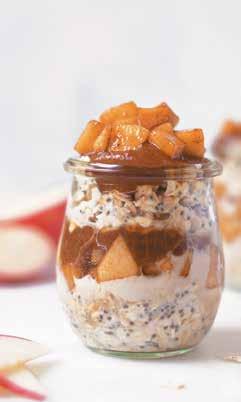
Reprinted from Clean-Eating Breakfasts
and Lunches Made Simple, by Lacey Baier. form salmon mixture into 2 patties and cook 4 minutes per side.
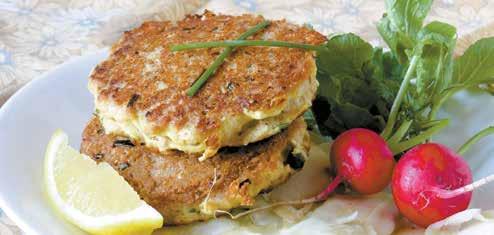
Place salmon cakes over fennel and parsnips and garnish with radishes. Serve warm.
Provided by David Perlmutter, DrPerlmutter.com.
Sweet Potato Toast with Avocado
1 large sweet potato 1 ripe avocado, sliced 1 package of tempeh (or 2 eggs) Extra-virgin coconut or olive oil Black pepper and sea salt
Cauliflower Hash Egg Muffins
This is a healthier, low-calorie alternative to the classic breakfast of hash browns and eggs, and more nutritious, too, because cauliflower is packed with fiber, minerals and vitamins. Plus, eating muffins for breakfast is always a good idea, especially when the muffins are good for you.

Smoked paprika and turmeric (optional) 2 large handfuls spinach or kale (optional) 1 to 2 Tbsp MCT oil (optional)
If using organic sweet potatoes, you don’t need to peel them because the skin contains lots of minerals and flavor. Just rinse and dry.
Cut the sweet potato in thin slices of 0.2 to 0.4 of an inch. Put them in your toaster on its highest setting. Repeat three to four times until the sweet potato is completely cooked.
You could also use your oven to make the sweet potato toast. Preheat at 350° F and roast for 5 to 10 minutes. Rub the sweet potato slices with some extra virgin coconut oil or olive oil and sea salt.
In the meantime, heat a spoonful of extra Fortunately, there are ways to make hash browns clean, because they’re amazing and need to be in the food rotation. First, use a little bit of olive oil instead of deep-frying, and opt for a healthier, low-carb alternative for potatoes, like cauliflower. Then, turn everything into muffins. Because it’s easier to prepare, they are great for a make-ahead breakfast and the flavors will be better. ½ Tbsp olive oil, plus more for greasing the pan ½ cup finely diced yellow onion 3 cups riced cauliflower 2 egg whites ¼ cup grated Parmesan cheese ½ tsp sea salt ¼ tsp ground black pepper ¼ tsp garlic powder 12 eggs 2 green onions, sliced, for garnish Preheat the oven to 425° F and grease a 12- cup muffin pan with olive oil. Heat the olive oil over medium-high heat in a large skillet. Add the onion, and cook until tender, 4 to 6 minutes. Add the cauliflower and cook until it becomes slightly tender, 3 to 4 minutes. virgin coconut oil in a frying pan. Cut the tempeh in smaller pieces and bake until golden. Flavor with black pepper and sea salt. I also love adding smoked paprika and turmeric. If you wish, you can add two large handfuls of spinach too.
Serve the sweet potato toast with sliced avocado, tempeh scramble and, if you wish, a spoonful of MCT oil to feel satisfied even longer. If you’re not a fan of avocado, you can replace it with nut cheese, pesto, nut butter or another topping that’s high in healthy fats and low in carbohydrates.
For a vegetarian version: replace the fried tempeh with one to two softly boiled or poached eggs.
Provided by Julie Van Den Kerchove,
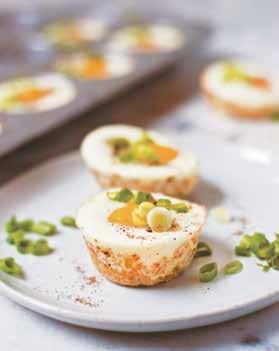
JuliesLifestyle.com. Transfer the cauliflower mixture to a large bowl, then add the egg whites, Parmesan, salt, pepper and garlic powder. Mix well.
Scoop a little less than ¼ cup of the cauliflower mixture into each muffin cup. Using your fingers or a spoon, press the cauliflower mixture down and around the sides of the muffin cups to create nests. Bake the nests for 18 to 20 minutes, or until the top edges become golden and crispy.
Reduce the heat to 375° F and remove the muffin pan from the oven.
Crack 1 egg into each cup, taking care not to overflow the nest. Return the pan to the oven and bake for 8 to 10 minutes, or until the egg whites are no longer transparent, but still a little loose. For fully cooked-through eggs, bake for 2 to 5 minutes longer.
To serve, garnish the muffins with the green onions. The muffins can be refrigerated, in an airtight container for up to 5 days. Reheat them in the microwave for 1½ minutes.
Reprinted from Clean-Eating Breakfasts and Lunches Made Simple, by Lacey Baier.
guilhermealmeida/Pexels.com
Calm Down Taming the Flames of Stress-Related Illness
by Marlaina Donato
We are beings of neurochemical and hormonal intricacy, and within this mixed bag of biology lies our magic. Our human experience is visceral; we cry from sadness and joy, flush from embarrassment, laugh with amusement and exhibit quirky mannerisms when we lie. Whether we see it as a blessing or a curse, we’re hardwired to embody the sacred fire of our emotions.
It also means that stress and our bodies are in perpetual partnership. “Systematically, the mind and body work together. Grabbing your belly when you hear bad news and saying, ‘I feel sick,’ or having ‘butterflies in your stomach’ are a testament to how everyday stress affects us physically,” says Stephanie Mansour, Chicago fitness expert and host of the national PBS show Step It Up With Steph.
“Stress serves a useful purpose by increasing alertness—the sometimes lifesaving ‘fight-or-flight’ response—but chronic stress leads to elevated stress hormones like cortisol and catechol- amines,” says emergency room physician Thomas Krisanda, at Northwest Hospital, in Randallstown, Maryland. “Cortisol can elevate blood glucose and suppress the immune system. Elevated catecholamines raise blood pressure and stress the heart. Over time, this can lead to hypertension, heart disease, kidney disease, diabetes or strokes.”
According to The American Institute of Stress, 77 percent of people experience the physical backlash of emotional stress in the form of headaches, chronic migraines, fatigue, digestive woes, muscle tension, dizziness and changes in libido. Research published this year in the Journal of the American Heart Associa- tion shows that children that experience severe adversity or live with alcoholics or drug addicts are at a 50 percent higher risk for developing cardiovascular disease later in life. Experts agree that this statistic goes beyond poor lifestyle choices, and might point to a biological inability to cope with everyday pressures.
Working with—rather than against—the body’s nervous sys- tem by employing lifestyle changes, releasing trauma and consid- ering options like a nourishing diet, safe herbal options and gentle energy modalities can help to break a vicious cycle.
Gut Instincts
Studies involving both mice and humans show that beneficial gut microorganisms are altered by emotional stress. The same bacteria responsible for bolstering the body’s fortress of immunity also

generate neurotransmitters like serotonin, dopamine and norepinephrine. These neurochemicals in the gut’s enteric nervous system control major biological functions that include heart rate, sleep cycles, muscle movement and mood.
While commonly prescribed antibiotics eradicate infectious invaders, they also kill off beneficial bacteria and neurotransmitters, opening the door to depressive disorders. Because approximately 95 percent of the body’s serotonin is produced in the gut, it’s not surprising that overuse of antibiotics has been associated with mental health conditions. British research published in the Journal of Clinical Psychiatry in 2015 documents case-control studies over an 18-year period involving 202,974 patients with depression. The findings show a high risk for anxiety and depression following repeated antibiotic use.
Connecting the dots further, 2018 research published in the Journal of Neuroendocrinology correlates compromised intestinal permeability with a weakened blood-brain barrier and alcohol addiction. Research published in 2014 in the journal PLOS One involving patients with irritable bowel syndrome (IBS) reveals abnormalities in catecholamines, elevated plasma cortisol and hyperactivity of the amygdala—the part of the brain that can become stuck on overdrive from trauma and other life stresses.
In a nutshell, negative emotional states can suppress immunity and foster more frequent antibiotic prescriptions and in turn, promote neurological loops of chronic depression and anxiety, and even more compromised immune response.
Functional gastrointestinal disorders like IBS and inflammation-driven Crohn’s disease are often exacerbated by emotional upset and improved with stress management techniques like biofeedback, cognitive behavioral therapy, psychoanalysis, hypnotherapy, meditation and breath work.
One Body, Many Selves
Resolving emotional trauma can offer unexpected hope for conditions that elude improvement or scientific understanding. A deeper look into how unrecognized or unreleased emotional pain can contribute to disease might help to solve the riddle of digestive problems, eczema, inflammatory bowel conditions and pain syndromes, including the multi-system agonies of fibromyalgia and chronic fatigue syndrome. It’s a widespread misunderstanding that psychosomatic (mind-body) health conditions are imaginary or the product of mental instability. In actuality, the term psychosomatic simply refers to
Everyday Practical Tips
From Stephanie Mansour:
n Deep breathing and rolling the shoulders forward and back a few times can relieve muscle tension.
n Eating something crunchy like an apple or carrots can lessen feelings of stress.
n Meditating for even one minute can help reduce excessive cortisol in the body. Doing small increments daily rather than over long intervals net better and bigger benefits. n If your mind is racing 24/7 and breathing techniques don’t work, change your environment. Get up and go to another room in the house. Go outside. If tight on space and can't go outside, turn your body to look in a different direction. Stay in the same spot on the couch and just look at something else. n Don’t put your body under more stress with demanding, cortisol-fuel-ing workouts; opt for yoga, meditation and Pilates.
n When you get your heart rate up (in as quickly as five minutes of doing cardio), you feel happier. n Maintain a healthy sleep schedule and go to bed earlier.
From Sarah Kate Benjamin:
n Reconnect to the earth in whatever way you can; go for a walk, cook a meal, smell flowers or just sit outside.
From LaStacia Ross:
n As an energy exercise, try what I call The Fountain of Light: See and feel white light coming up from the earth and into your feet. Feel it move all the way up through your body, out of your head and back down to your feet to start again, like a fountain. Repeat this many times, feeling the vibrant, white light energy flowing through you.
physical diseases with no organic origin that are presumed to have unconscious emotional taproots.
“We are made up of different types of energy,” explains LaStacia Ross, a reiki mas- ter and sound healer at Eclectic Soul Studio, in Pittsburg, Kansas. “Physical or sensory energy is the energy of the physical body. Our outer energy field is subtle energy which consists of layers and includes thoughts and emotions. I like to think of the subtle energy field as a library containing the records of everything we’ve ever experienced.”
Reiki, a form of non-touch therapy, is now deemed valuable by many respected hospitals, like the Memorial Sloan Ketter- ing Cancer Center, in Manhattan. Spring- boarding from the philosophy that we are trinities of body, mind and spirit, reiki and other forms of energy medicine aim to encourage the flow of vital life force. Ross, who also uses sound resonance via tuning forks in her work, has witnessed significant improvement in her clients. “Energy work can help release stored energetic patterns of trauma and stress that no longer serve us,” she says. “Relaxation is an immediate benefit of energy work. People often feel a huge mental weight lifted and report pain relief, sometimes after just one session.” Despite the many gains of energy work, Ross emphasizes individual timing. “On a subconscious level, pain or illness can serve us in some way without us realizing it. Sometimes we’re not ready to work through our issues or let them go, even if we think we are.”
Investing in Equilibrium
Stress-induced psychosomatic illness does not discriminate, and even affects members of the medical field. A 2009 study pub- lished in the Indian Journal of Occupational and Environmental Medicine found that professional burnout in nurses can man- ifest as back and neck pain, acidity, anger and impaired memory.
Krisanda underscores the importance of self-care in all walks of life. “If you don’t take care of yourself, you are useless to care for others. Adopt a healthy diet and exer- cise and make it a routine. We live in a very materialistic society, and I believe this also leads to stress, unhappiness and a sense of being entitled and never being satisfied. Just let go.”
Plant Power for Combatting Stress
Sarah Kate Benjamin’s Personal Favorites:
Passionflower (Passiflora incarnata) soothes restless minds from anxiety and insomnia, and eases menstrual cramps or muscle spasms. Skullcap (Scutellaria lateriflora) helps to strengthen the brain and revitalize the central nervous system, and helps to calm the mind and relieve nervous stress and headaches. It is even more beneficial when combined with lavender or chamomile. Chamomile (Matricaria chamomilla) helps to soothe emotional and muscle tension; relieve stress-related gut symptoms like gas, cramping, irritable bowel syndrome and ulcers; calm heat-re- lated emotional and physical issues such as ecze- ma, anger and frustration; and generally promote a sense of calm. Wonderful in baths, teas and as an herbal garnish.
In addition to Benjamin’s recommendations, other stress-fighting herbs to consider are Ginkgo, panax and Siberian ginseng, fo-ti, rhodiola, reishi mushroom, goji berries, licorice root, lavender, rose, lemon balm, tulsi (holy basil), ashwagandha and mimosa bark.
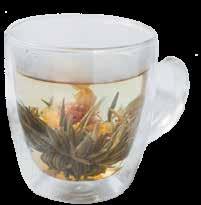
He also stresses the importance of support. “An emergency room is an in- credibly hectic, frightening and sometimes violent place. I rely on my colleagues, and we support each other. For me, the most important thing is to realize that I’m not in it alone.” Krisanda also finds balance by taking a few minutes in a quiet place to collect his thoughts and enjoy a peaceful moment.
Basic, whole foods can help to main- tain homeostasis. “Make sure that food is fueling you,” says Mansour. “Cooked vegetables and broths are very soothing. Instead of a juice cleanse or an extreme diet, focus on nourishing, calming foods like soups, lean proteins to stabilize blood sugar levels and healthy fats to support brain function. Reducing alcohol can help improve liver function.”
Sarah Kate Benjamin, a holistic chef and herbalist in Sebastopol, California, finds her own healing rhythms by eating with the seasons and using medicinal plants in inspired, everyday dishes. Co-author of The Kosmic Kitchen Cookbook: Everyday Herbalism and Recipes for Radical Wellness, she sees herbs as life-giving examples of resilience. “Herbs have been here long before us and have experienced their own form of stressors. Working with nervous system-supportive herbs in my food, bev- erages or even as tinctures really help me find balance when I’m overwhelmed.”
Some of her allies are oat tops, lemon balm, skullcap, chamomile and passion- flower. For Benjamin, everyday choices play a huge role in healing. “Making small lifestyle shifts in your work or home life can really help you move into a more relaxed state. I like to think of it as a sort of mantra: ‘Help the herbs help you,’” she says. In a world that is fixated on ex- ternal validation, little things matter. “If I give myself permission to do the things that really nourish me, I’ll be the best version of myself. Perhaps most importantly, I will like me, and that matters tremendously.”
Marlaina Donato is an author and recording artist. Connect at AutumnEmbersMusic.com.












